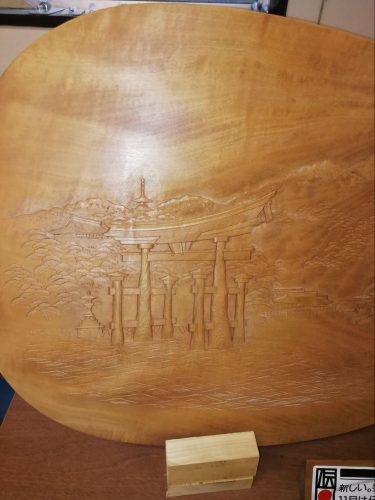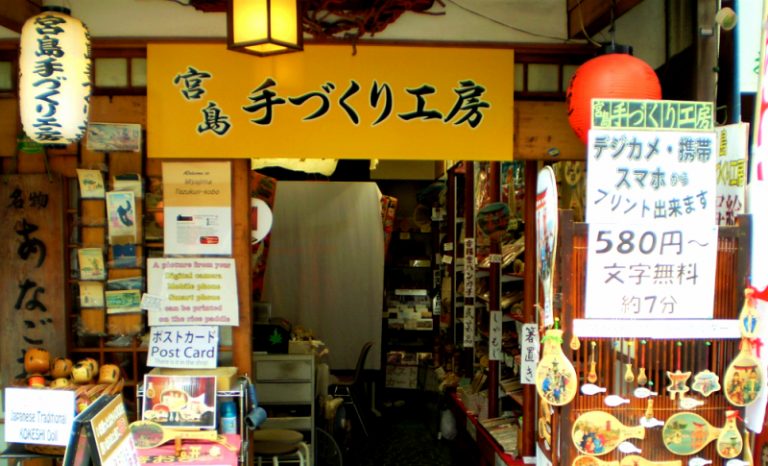100 Stories
CARVING OUT A MEMORABLE AND TRADITIONAL MIYAJIMA EXPERIENCE — Miyajima Traditional Crafts Center
Nearly every visitor to Miyajima, the crown jewel of Hiroshima tourism, comes out of the ferry terminal and, if not immediately way-laid by the famous Miyajima deer, heads quickly off to the right. No blame or shame in that – the great torii gate standing in the water is surely what they came to see. But if you are interested in adding a very cool, fun, memorable and treasurable experience to the usual sightseeing, then amidst the viewings of the gate, Itsukushima shrine, the cable car to the mountaintop and all the other Miyajima offerings, come on back to the ferry terminal, and this time drift left. Directly across from the smaller pier three of the port stands Miyajima Traditional Crafts Center. Three wonderful hands-on experiences await, giving you both amazing memories and forever souvenirs to take home.

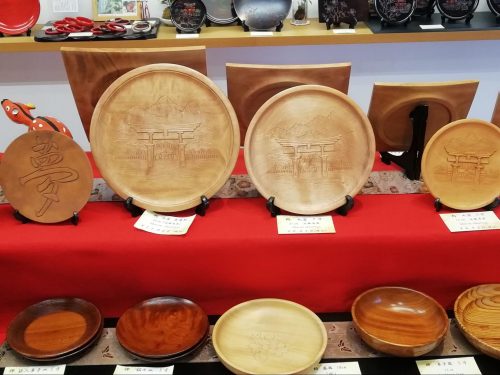
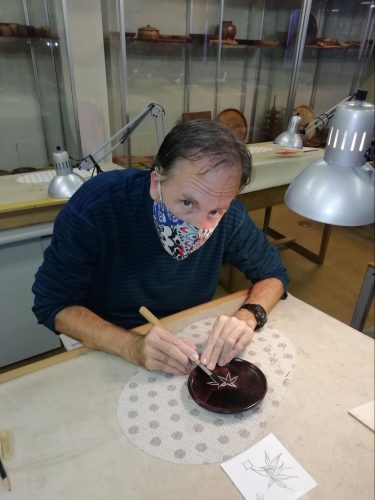
THE CENTER
Miyajima Traditional Crafts Center is a modest three-story building, with only a simple signboard to suggest it’s more than a humble residence. However, it is, in fact, a building actively involved in not only preserving some of Hiroshima’s famous craft works, but in promoting the learning and experiencing of these crafts in a hands-on manner. I was honestly excited when I first saw the sign – it’s not extremely well known, and even I had missed it many times in previous visits. After discovering it, I couldn’t wait to try it out.
The three traditional crafts available to experience are: momiji-manju making, shakushi (rice paddle) making, and Miyajima-bori wood carving. Momiji-manju are everywhere on Miyajima, and really all through Hiroshima. These little maple-leaf waffle cakes are the most popular souvenir of Miyajima, and elsewhere on the island you can eat them, watch them be made, and even deep-fry them. At the Traditional Crafts Center, you get to make one yourself, from scratch. The rice paddles you will also see everywhere during your visit. If you are going to buy one, however, why not one that you personally added design to? Finally, the wood carvings, as well, you’ll notice all around the island, but with much more variety in style and size you might not recognize it as a specific traditional craft, with ties to Hiroshima. Essentially, they are the lacquered wood pieces you’ll see with beautifully colorful designs etched directly into the wood.
It’s possible to accomplish all three tasks in a day (each takes an hour or a little less) if your interest is piqued, but you’ll need a little luck with your timing. When I was first trying to make my reservations, I had issues with availability – both in terms of the availability of a teacher, and the availability of a slot for me when there were many willing participants. In fact, one day was completely out because a school had booked time at the center for its students on their school trip. Kudos to that school. Having time in the afternoon once, I learned that, on that day at least, the shakushi and momiji-manju experiences were only available in the morning.
That said, the Center was very gracious and accommodating, as well as they could be. No simple “no” from them, there was much checking of schedules, consideration of the possibility of mixing me in with another group, and even a phone call to a teacher at home to confirm that they could come in just for me. There is an online site I viewed which states they can handle up to 40 people at a time, but also states you must have a group of five or more. However, when I called about coming solo, there was no hesitation in accepting my request. Reservations are required, however. Walk-ins are sure to be regretfully denied. The reservations can be made up to a year in advance, however, so your best bet for experiencing all three activities is contact well in advance.
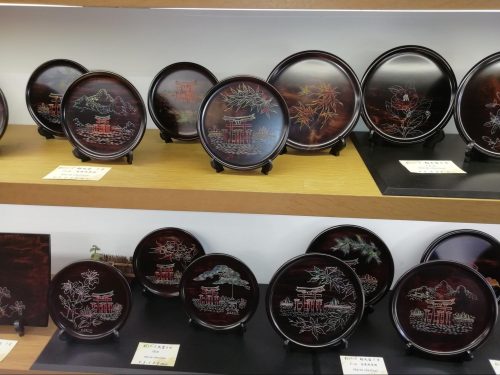
MAPLE LEAF WAFFLE CAKES
Manju is the name of the traditional Japanese waffle cake, made by wrapping a kneaded dough made from wheat around flavored ingredients, primarily the particularly Japanese azuki bean jam. The momiji-manju, however, has become the true champion of all manju, easily the best known. What sets it apart is it’s maple-leaf design. This didn’t come about by accident. The island of Miyajima is quite famous for its maple trees. If you are around in mid-to-late November you’ll get a visual feast to go along with the actual feast of momiji-manju. As the story goes, one of ryokan (Japanese-style) inns in Momiji-dani (Maple Leaf Valley) specifically requested of a confectioner for a snack to represent the area that could use the Momiji name. Thus, in 1906, the first momiji-manju was created. Now, they are everywhere and a beloved symbol of both Miyajima and Hiroshima.
While sold everywhere, the vast majority are machine-produced. In fact, a few of the shops along the famous shopping street between the ferry terminal and the gate have glass windows specifically so you can watch the manju being made. An assembly-line machine pours batter into present molds and closes the waffle iron case around them one-by-one. At Miyajima Traditional Craft Center, however, you will begin the process from the mixing of the batter itself. And while, of course, a type of waffle iron is used, you’ll be doing the pouring and the closing. This is not about just flipping a switch. This is you making it from scratch. It might even tempt you to try and get a mold so you can keep making them in your home.
Impressively, the Crafts Center also offers a menu of 20 flavors, so you can truly make your own special manju. Most of the shops offer up to eight flavors, so 20 was a surprise to me. Along with several variations of the traditional azuki bean jam as mentioned above, including a white version, you can also go with chocolate on the inside OR a chocolate coating on the outside. For fruit lovers, I noticed lemon, pear, peach, grape and tangerine. Personally, I’m a cheese cream man all the way.
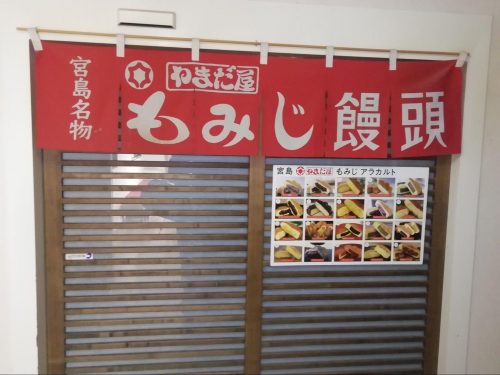
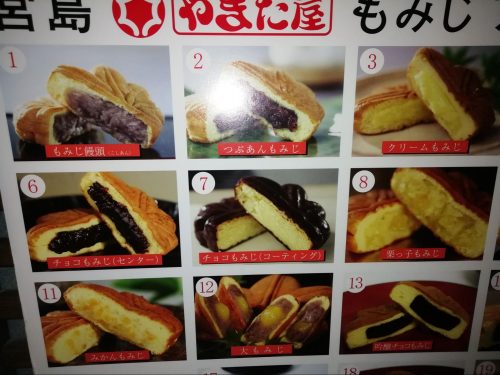
RICE SCOOPS
Seemingly all Japanese eat at least once a day, most eat it at least twice, and traditionally, and still common now, rice is eaten with each meal of the day. This is why every household in Japan has a rice cooker. And also, every household need rice scoops. Realization of this, long, long ago, was what led to the industry become synonymous with Miyajima. As the story goes, around 1800 a Buddhist monk named Seishin dreamed of a goddess holding a lute in the shape that is now the rice scoop. From that vision he determined that Miyajima, rather than rely merely on the donations at Itsukushima shrine, could survive on craft and industry. So he taught others and for centuries now the rice scoop has been a leading souvenir of Miyajima. There is a monument to Seishin up on Mt. Misen, and there is also the world’s largest rice scoop (7.7 meters long and 2.5 tons!) to be viewed along the shopping street.
The scoops are also believed to bring luck and health. As the saying goes, you can scoop up good fortune along with your rice. There is even a temple (Senjokaku) next to the 5-story pagoda on the island that has its inner walls and even rafters plastered with hundreds and hundreds of rice scoops. Legend says many were placed there by soldiers, hoping to scoop enough luck to return home safely.
So with that historical background, why not have a go at designing and making your own traditional rice scoop, bring luck, health and lifelong memory into your home. At the Traditional Crafts Center, you’ll be treated to a bit of the history of shakushi, rice-scoop making (perhaps I should have written spoiler alert above. Ha ha), and then you will get to work on your own rice scoop. Done as a sort of branding process, you’ll choose options similar to cookie cutters, and then decide where and how to burn your design into your paddle. Thus, everyone’s paddle will be unique.
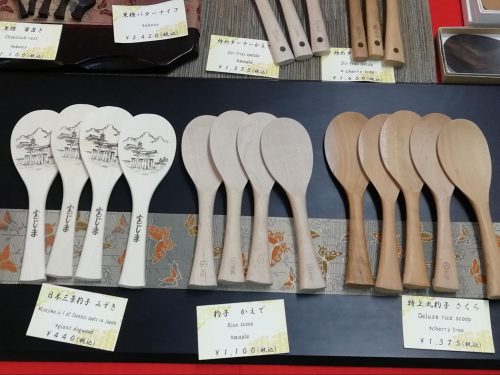
MIYAJIMA=BORI WOOD CARVING
Slightly newer as a Miyajima-based craft than the rice scoop, Miyajima-bori, or wood carvings, still have a 150 year history in the area. Tracing back to the master, Hagii Shosai, around 1860, his pupils began to prominently feature Itsukushima shrine and the great torii gate in their designs. These, along with deer and monkeys on trays and bowls soon made the whole country fascinated by Miyajima. When a craftsman from Miyajima won a prize in 1877 at a Tokyo exhibition of Japanese industries, Miyajima-bori’s popularity was sealed, and many craftsman came to learn.
Products such as trays, bowls, tea cases, screens, and frames are made from various woods such as cherry tree, Japanese chestnut, mulberry and bamboo, with Miyajima-style carving being famous for being able to maintain the natural grain of the wood. The elaborate carvings work to bring out both the natural beauty of the wood itself, as well as the beautiful scenes of nature and Miyajima for which they are known. Some of the truly impressive large-sized carvings are available to be seen in the workshop, some of which took months to a year to complete.
At the Traditional Crafts Center you will be given a stenciled-design to follow, but otherwise all the creation will be done by you. You’ll be taught how to transfer the design to your lacquered tray, how to correctly carve out the stencil, and then how to paint and decorate it. By also engraving your name into it, you’ll have what appears to be a wonderful store-bought souvenir, but you’ll get to boast to your friends that, in fact, you made it yourself.

MY CARVING EXPERIENCE
I think all three experiences are wonderful. But I’ve been in love with Miyajima-bori carvings since I first came to Hiroshima, since even before I knew its name or that it was truly a traditional Miyajima-based craft. I’ve wandered through many a souvenir shop looking at them. A sharp eye will even let you notice that the colors and motifs are the carvings are also reproduced in other souvenirs, even T-shirts. So I was all in on trying to make one for myself.
After getting a reservation finally squared away, I was given a one-on-one lesson with Ono-sensei. He appeared young (I had somehow imagined a venerable teacher for a traditional craft), but he said he’s been training in the art for over 12 years. His sensei’s sensei was the one who carved the large pieces in the workshop that so caught my eye. Wasting no time, he immediately sat me down and got to work. I was impressed how he had everything laid out and waiting for me well before my arrival. Care and attention to detail become natural traits when you are a craftsman, it seems.
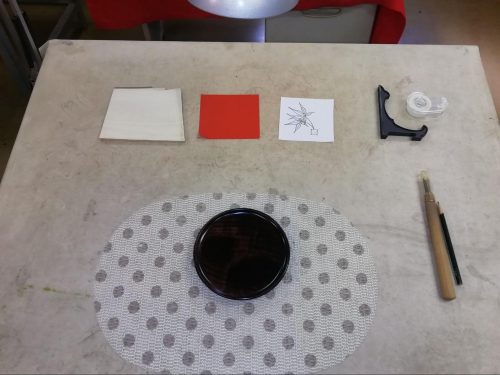
We can with a brief overall explanation of what the steps would be, right down to the final step of painting. I was then given my small tray and my stencil. If I had any quibble with the experience at all, there was only the one stencil. I didn’t have any options regarding design. More the shakushi experience I would have wanted some sense of creativity and design control. That said, the stenciled design was a double maple-leaf, very traditional, attractive, and sufficiently intricate that it actually surprised me a little, seeming a tough challenger for someone’s first try.
Given the stencil and a piece of carbon paper, you carefully trace the entire design onto your tray. There are many lines to trace, actually, and you need to be careful not to miss a single one. You are often given your one moment of creative license, a space to carve your name, emblem, or however you’d like to mark it as yours. I went with a simple JB. In the end I kind of regretted that though, because the curve of the J and the double curve of the B were quite difficult for a newbie like me. But I’m getting ahead of myself.
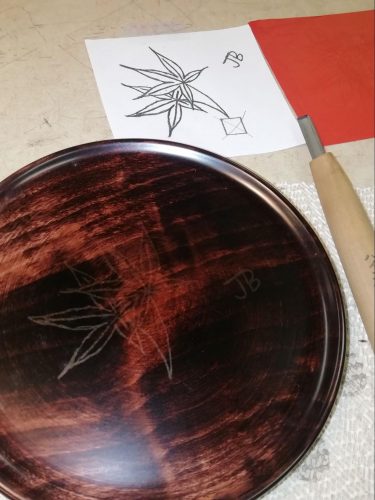
We can with a brief overall explanation of what the steps would be, right down to the final step of painting. I was then given my small tray and my stencil. If I had any quibble with the experience at all, there was only the one stencil. I didn’t have any options regarding design. More the shakushi experience I would have wanted some sense of creativity and design control. That said, the stenciled design was a double maple-leaf, very traditional, attractive, and sufficiently intricate that it actually surprised me a little, seeming a tough challenger for someone’s first try.
Given the stencil and a piece of carbon paper, you carefully trace the entire design onto your tray. There are many lines to trace, actually, and you need to be careful not to miss a single one. You are often given your one moment of creative license, a space to carve your name, emblem, or however you’d like to mark it as yours. I went with a simple JB. In the end I kind of regretted that though, because the curve of the J and the double curve of the B were quite difficult for a newbie like me. But I’m getting ahead of myself.

Once that was finally finished, it was over to the paint table. Not as I expected, it was water-colors, not solid paints. Also, the technique is to dab at the tray near and around the design, not try to paint into the etchings themselves directly. The idea is to let the water colors seep into the cracks. This allows for the best gradation effect as you can continue dabbing with various colors and let them blend. Shockingly, the next technique is to blow-dry the wood, drying the paint in the crevices, but thanks to the lacquer finish, allows the rest of the paint to just be wiped away with the rag. You can actually repeat the process several times if you are not satisfied with your colorings. I liked my first result, but found it slightly two monochrome, so I went at it again to get some variation in my two leaves. When I achieved a cool yellow tip to my orange-ish leaf I knew I was done and I was thrilled with my result.
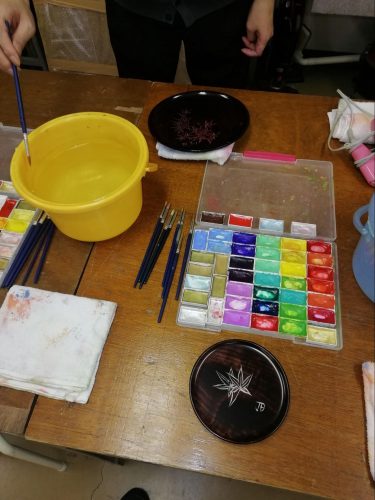
MOMENT OF JOY
After finishing, and already being quite thrilled with my result, Ono-sensei showed me a little plastic foldable display stand. He told me I could use my creating as a little tray, or I could use the stand and display it. I thought at first that he meant this just by way of explanation, but then I realized the display stand was a present. When I set my piece on the stand and thought it looked as good as any in the souvenir shops, that was my moment of joy.
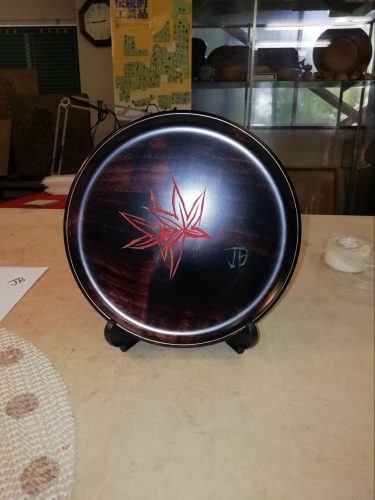
MEMORABLE, YET REASONABLE
The Mijima-bori experience is 1,900 yen. Considering a tray of similar size in the shops would be between 1 and 2,000 yen, and considering that cost included the explanation, tray, paints and display stand, I thought it was a great bargain. One of the best offerings on Miyajima. The other two experiences are probably even more so. The momiji-manju making experience is around 600 yen, and you get to eat your result of course. And the shakushi rice scoop is actually under 400 yen, when you could easily be buying a generic scoop for the same price out in the shops.
An hour sometimes feels long when planning a sightseeing excursion, especially in a place like Miyajima where there is already so much to see and do. But to create your own original souvenir, in a craft that Miyajima is renowned for, that you will be able to save forever alongside your photographs and such, personally I find it well worth it. I’m very likely to go again. Hopefully, I’ll see you there.
